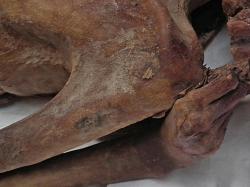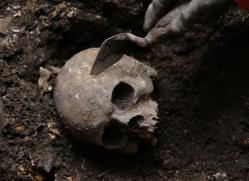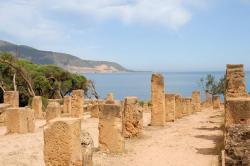INSTITUT SUPERIEUR D'ANTHROPOLOGIE
INSTITUTE OF ANTHROPOLOGY
ONLINE COURSES / COURS A DISTANCE
SPRING TERM : APRIL 2018
REGISTER NOW
TURQUIE –  Istanbul - A Roman-era sarcophagus, believed to date back 2000 years, has been unearthed during a construction work in Istanbul’s Kadıköy district, daily Habertürk has reported. Officials at the Istanbul Archaeology Museum Directorate found human bones inside the sarcophagus after conducting an examination in the area. The lid of the sarcophagus was found in a different place. The bones inside the tomb will be examined and undergo DNA tests, officials said. The examinations will provide information about the residents of Kadıköy, now a culture hotspot in Istanbul, 2,000 years ago. Speaking about the finding found in the Kuşdili Çayırı area, archaeologist Murar Sav said: “Kuşdili Çayırı and its vicinity are close to or inside the ancient city of Khalkedon. There was a settlement in Khalkedon in seventh century B.C., when the ancient Byzantion was founded. On the left side of Kurbağalıdere Stream is the necropolis of the ancient Khalkedon and the tomb was found on the right side of the stream. It is also believed that there was an old harbor at the spot where the stream meets the sea.” Sav said that the tomb dated back to the Roman era, adding: “There is no relief or writing on the tomb. Had there been engravings, we could’ve said the tomb belonged to a rich person, but it didn’t belong to an ordinary person either. There was no gift in the tomb. The excavation area should be expanded to find other tombs around.”
Istanbul - A Roman-era sarcophagus, believed to date back 2000 years, has been unearthed during a construction work in Istanbul’s Kadıköy district, daily Habertürk has reported. Officials at the Istanbul Archaeology Museum Directorate found human bones inside the sarcophagus after conducting an examination in the area. The lid of the sarcophagus was found in a different place. The bones inside the tomb will be examined and undergo DNA tests, officials said. The examinations will provide information about the residents of Kadıköy, now a culture hotspot in Istanbul, 2,000 years ago. Speaking about the finding found in the Kuşdili Çayırı area, archaeologist Murar Sav said: “Kuşdili Çayırı and its vicinity are close to or inside the ancient city of Khalkedon. There was a settlement in Khalkedon in seventh century B.C., when the ancient Byzantion was founded. On the left side of Kurbağalıdere Stream is the necropolis of the ancient Khalkedon and the tomb was found on the right side of the stream. It is also believed that there was an old harbor at the spot where the stream meets the sea.” Sav said that the tomb dated back to the Roman era, adding: “There is no relief or writing on the tomb. Had there been engravings, we could’ve said the tomb belonged to a rich person, but it didn’t belong to an ordinary person either. There was no gift in the tomb. The excavation area should be expanded to find other tombs around.”
http://www.hurriyetdailynews.com/ancient-tomb-found-in-istanbuls-kadikoy-128033
EGYPTE –  Gebelein - Scientists have discovered the world’s oldest known tattoo art – hidden on an ancient Egyptian mummy which has been on public display at the British Museum for the past 100 years. Previously, all that academics and museum visitors alike had been able to see were faint, dark smudges on the man’s right arm. But recent infrared examination has revealed the marks are in fact tattoos depicting two animals – a giant wild bull and a wild North African goat-like creature. It is likely the man wore his tattoos in order to help project an image of strength and macho virility. Throughout much of the ancient world, both types of animal were often associated with male power, virility, fertility and creation. The two animals were tattooed onto the man’s arm some 5,200 years ago. Along with a Copper Age European of almost identical vintage, found preserved in an Alpine glacier, the ancient Egyptian is the oldest tattooed individual ever discovered. Examination of the art suggests they were made with a carbon-based pigment, probably soot. The bull portrayed in the larger of the man’s two tattoos represented a now-extinct species of giant wild bull, known as the aurochs. They were feared, admired and often worshipped throughout parts of the ancient world. They are likely to have been the origin of many of the great bull legends of antiquity – the story of the Cretan Minotaur, the Mesopotamian Bull of Heaven and the Anatolian bull-shaped God of Storms. In ancient Egyptian religion, there are three bull gods, each symbolising either fertility or war. The other animal, a goat-like creature known as a Barbary sheep and portrayed in tattoo form on the British Museum ancient Egyptian, may likewise have been associated with male virility. Throughout much of the ancient world, goat-like creatures were often associated with masculine sexuality. In Greece, they feature in mythology as often erotic Pan, god of the wild. In ancient Egypt, the ram was sometimes perceived as a primeval force linked to procreation. Indeed, there were three Egyptian sheep gods linked to fertility and creation.
Gebelein - Scientists have discovered the world’s oldest known tattoo art – hidden on an ancient Egyptian mummy which has been on public display at the British Museum for the past 100 years. Previously, all that academics and museum visitors alike had been able to see were faint, dark smudges on the man’s right arm. But recent infrared examination has revealed the marks are in fact tattoos depicting two animals – a giant wild bull and a wild North African goat-like creature. It is likely the man wore his tattoos in order to help project an image of strength and macho virility. Throughout much of the ancient world, both types of animal were often associated with male power, virility, fertility and creation. The two animals were tattooed onto the man’s arm some 5,200 years ago. Along with a Copper Age European of almost identical vintage, found preserved in an Alpine glacier, the ancient Egyptian is the oldest tattooed individual ever discovered. Examination of the art suggests they were made with a carbon-based pigment, probably soot. The bull portrayed in the larger of the man’s two tattoos represented a now-extinct species of giant wild bull, known as the aurochs. They were feared, admired and often worshipped throughout parts of the ancient world. They are likely to have been the origin of many of the great bull legends of antiquity – the story of the Cretan Minotaur, the Mesopotamian Bull of Heaven and the Anatolian bull-shaped God of Storms. In ancient Egyptian religion, there are three bull gods, each symbolising either fertility or war. The other animal, a goat-like creature known as a Barbary sheep and portrayed in tattoo form on the British Museum ancient Egyptian, may likewise have been associated with male virility. Throughout much of the ancient world, goat-like creatures were often associated with masculine sexuality. In Greece, they feature in mythology as often erotic Pan, god of the wild. In ancient Egypt, the ram was sometimes perceived as a primeval force linked to procreation. Indeed, there were three Egyptian sheep gods linked to fertility and creation.
http://www.independent.co.uk/news/science/archaeology/worlds-oldest-tattoo-egypt-mummy-british-museum-infrared-a8233536.html
IRAQ –  Babylone - The heavy rains that hit Iraq over the past two weeks have not only put an end to the dry season, which has almost dried up the historic Tigris River, but it also helped uncover hundreds of historical ruins that were washed away in Babylon, one of the country’s most important archaeological sites. Hussein Fleih, Babylon's director of antiquities, said in a press statement: "Among the findings were pottery utensils, coins and metal pieces." "The discoveries will be examined to determine the exact historical period they date back to," he added, suggesting that they belong to the Parthian and Islamic eras. "Last year, 1,000 pieces were discovered this way, which proves that the ruins may be close to the surface and not always buried deep in the ground," Fleih said. Such discoveries after heavy rainfall are not rare in Iraq.
Babylone - The heavy rains that hit Iraq over the past two weeks have not only put an end to the dry season, which has almost dried up the historic Tigris River, but it also helped uncover hundreds of historical ruins that were washed away in Babylon, one of the country’s most important archaeological sites. Hussein Fleih, Babylon's director of antiquities, said in a press statement: "Among the findings were pottery utensils, coins and metal pieces." "The discoveries will be examined to determine the exact historical period they date back to," he added, suggesting that they belong to the Parthian and Islamic eras. "Last year, 1,000 pieces were discovered this way, which proves that the ruins may be close to the surface and not always buried deep in the ground," Fleih said. Such discoveries after heavy rainfall are not rare in Iraq.
https://aawsat.com/english/home/article/1189666/rain-iraq-ends-drought-uncovers-historic-ruins
ROYAUME UNI –  Margate Caves - Today, the final act was to lift an Iron Age skeleton, found on the last day of the two-week community excavation. The skeleton was a crouch burial: the body laid as if curled up and sleeping, in the bottom of a bell-shaped chalk pit. Looking up from the pit today to blue skies and seagulls above, it was easy for the years to slip away, and to be able to imagine the small Iron Age community living a rural life on this site.
Margate Caves - Today, the final act was to lift an Iron Age skeleton, found on the last day of the two-week community excavation. The skeleton was a crouch burial: the body laid as if curled up and sleeping, in the bottom of a bell-shaped chalk pit. Looking up from the pit today to blue skies and seagulls above, it was easy for the years to slip away, and to be able to imagine the small Iron Age community living a rural life on this site.
https://theisleofthanetnews.com/dan-thompson-an-iron-age-skeleton-at-the-margate-caves-dig/
FRANCE –  Montmorillon - Une vingtaine de corps ont été découverts depuis le début des travaux de terrassement au pied de l’église Notre-Dame, le 12 février dernier. Le chantier vise à assainir les fondations de l’édifice en les aérant, afin de faire baisser l’humidité qui dégrade la crypte Sainte-Catherine et ses peintures illustrant la vie (et la mort) de la martyre. Trouver des sépultures à cet endroit n’est pas une surprise. L’actuelle place Régine-Deforges (ex-place du Terrier) a été le cimetière paroissial pendant des siècles. « On s’y attendait mais nous trouvons plus de vestiges que prévu, c’est assez dense, indique Florence Boisserie, archéologue de la société Atemporelle, chargée du suivi archéologique des travaux. Nous traitons les vestiges qui apparaissent au fur et à mesure », précise-t-elle pendant que ses deux collègues dégagent des ossements, au pied de l’excavatrice à l’arrêt. « Les corps [inhumés en pleine terre] ne sont pas datés pour le moment, ils sont en assez mauvais état de conservation. Les premiers coups de pelle ont aussi mis au jour des éléments de maçonnerie qui pourraient être des renforts du mur de l’église. « Ces fouilles sont très intéressantes pour apporter des renseignements sur des périodes peu connues et la durée d’utilisation de ce cimetière, sans doute contemporain de l’église, c’est-à-dire XIe et XIIe siècle. Il a été fermé et déplacé en 1783 », indique Béatrice Guyonnet, animatrice du patrimoine à la communauté de communes.
Montmorillon - Une vingtaine de corps ont été découverts depuis le début des travaux de terrassement au pied de l’église Notre-Dame, le 12 février dernier. Le chantier vise à assainir les fondations de l’édifice en les aérant, afin de faire baisser l’humidité qui dégrade la crypte Sainte-Catherine et ses peintures illustrant la vie (et la mort) de la martyre. Trouver des sépultures à cet endroit n’est pas une surprise. L’actuelle place Régine-Deforges (ex-place du Terrier) a été le cimetière paroissial pendant des siècles. « On s’y attendait mais nous trouvons plus de vestiges que prévu, c’est assez dense, indique Florence Boisserie, archéologue de la société Atemporelle, chargée du suivi archéologique des travaux. Nous traitons les vestiges qui apparaissent au fur et à mesure », précise-t-elle pendant que ses deux collègues dégagent des ossements, au pied de l’excavatrice à l’arrêt. « Les corps [inhumés en pleine terre] ne sont pas datés pour le moment, ils sont en assez mauvais état de conservation. Les premiers coups de pelle ont aussi mis au jour des éléments de maçonnerie qui pourraient être des renforts du mur de l’église. « Ces fouilles sont très intéressantes pour apporter des renseignements sur des périodes peu connues et la durée d’utilisation de ce cimetière, sans doute contemporain de l’église, c’est-à-dire XIe et XIIe siècle. Il a été fermé et déplacé en 1783 », indique Béatrice Guyonnet, animatrice du patrimoine à la communauté de communes.
https://www.lanouvellerepublique.fr/vienne/montmorillon-un-cimetiere-ancien-mis-au-jour-a-notre-dame?queryId%5Bquery1%5D=57cd2206459a452f008b4594&queryId%5Bquery2%5D=57c95b34479a452f008b459d&page=9&pageId=57da5cf3459a4552008b49d5
BELGIQUE –  Abri des Autours - Des outils datant de la période Néolithique et un collier ont été découverts lors de récentes recherches sur plus de 200 restes d'os d'animaux provenant des fouilles du site de l'Abri des Autours, une petite grotte près de Dinant. Ces spécimens ont été trouvés dans une tombe collective de la culture néolithique du Michelsberg, datant d'il y a plus de 6.000 ans. Un fait exceptionnel. L'Abri des Autours a été fouillé pour la première fois dans le début des années 90. L'analyse des restes osseux a été réalisée récemment par une équipe dirigée par Quentin Goffette de l'Institut Royal des Sciences Naturelles de Belgique à Bruxelles. L'étude a été publiée dans la revue scientifique Anthropozoologica."Les restes de trois adultes et de six enfants ont été découverts dans la sépulture datant du Néolithique", explique M. Goffette. "Dispersés dans la grotte, les archéologues ont trouvé 230 restes d'os d'une faune très diversifiée. Six d'entre eux ont été retravaillés et un a été utilisé comme un petit pendentif. Il s'agit d'une dent d'une biche percée par un petit trou." Les autres outils comprenaient une aiguille faite à partir de la fibula d'un cochon ou d'un sanglier, des côtes aiguisées, provenant vraisemblablement d'une vache et quelques outils fabriqués à partir des bois d'un cerf élaphe. Les archéologues n'ont pas pu identifier la personne a qui appartenaient ces objets. Les restes osseux humains ont peut-être encore été manipulés durant la période Néolithique.
Abri des Autours - Des outils datant de la période Néolithique et un collier ont été découverts lors de récentes recherches sur plus de 200 restes d'os d'animaux provenant des fouilles du site de l'Abri des Autours, une petite grotte près de Dinant. Ces spécimens ont été trouvés dans une tombe collective de la culture néolithique du Michelsberg, datant d'il y a plus de 6.000 ans. Un fait exceptionnel. L'Abri des Autours a été fouillé pour la première fois dans le début des années 90. L'analyse des restes osseux a été réalisée récemment par une équipe dirigée par Quentin Goffette de l'Institut Royal des Sciences Naturelles de Belgique à Bruxelles. L'étude a été publiée dans la revue scientifique Anthropozoologica."Les restes de trois adultes et de six enfants ont été découverts dans la sépulture datant du Néolithique", explique M. Goffette. "Dispersés dans la grotte, les archéologues ont trouvé 230 restes d'os d'une faune très diversifiée. Six d'entre eux ont été retravaillés et un a été utilisé comme un petit pendentif. Il s'agit d'une dent d'une biche percée par un petit trou." Les autres outils comprenaient une aiguille faite à partir de la fibula d'un cochon ou d'un sanglier, des côtes aiguisées, provenant vraisemblablement d'une vache et quelques outils fabriqués à partir des bois d'un cerf élaphe. Les archéologues n'ont pas pu identifier la personne a qui appartenaient ces objets. Les restes osseux humains ont peut-être encore été manipulés durant la période Néolithique.
http://www.levif.be/actualite/belgique/de-rares-offrandes-decouvertes-dans-une-sepulture-du-neolithique-pres-de-dinant/article-normal-805649.html
ALGERIE –  Tipaza - Un site archéologique a été découvert, hier, sur un chantier de l’AADL dans la wilaya de Tipaza. Le directeur de la culture de cette localité, Djilali Zebda, a indiqué que ce sont «deux tombes de près de deux mètres de long et d’un caveau renfermant des ustensiles», datant probablement de l’époque romaine, qui ont été découverts. Le Centre national de recherche en archéologie (CNRA) va procéder à des analyses qui établiront avec plus de précision la période d’origine de ces vestiges. Ces derniers ont été découverts sur le chantier de construction. Ce n’est pas la première fois que des «ruines» sont découvertes à Tipaza. En 2008 déjà, des éléments archéologiques ont été «déterrés» sur le chantier de la cité universitaire. Plusieurs autres découvertes ont été faites.
Tipaza - Un site archéologique a été découvert, hier, sur un chantier de l’AADL dans la wilaya de Tipaza. Le directeur de la culture de cette localité, Djilali Zebda, a indiqué que ce sont «deux tombes de près de deux mètres de long et d’un caveau renfermant des ustensiles», datant probablement de l’époque romaine, qui ont été découverts. Le Centre national de recherche en archéologie (CNRA) va procéder à des analyses qui établiront avec plus de précision la période d’origine de ces vestiges. Ces derniers ont été découverts sur le chantier de construction. Ce n’est pas la première fois que des «ruines» sont découvertes à Tipaza. En 2008 déjà, des éléments archéologiques ont été «déterrés» sur le chantier de la cité universitaire. Plusieurs autres découvertes ont été faites.
http://www.algerie-focus.com/2018/02/tipaza-site-archeologique-decouvert-sous-chantier-de-laadl/